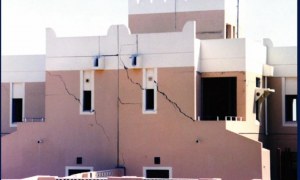🕑 Reading time: 1 minute
Compaction is the process of expulsion of air from the voids present in the soil. In the construction field, it is
It is known that the soil becomes dense when it undergoes compaction. To facilitate easy compaction, some amount of water is added to the soil and the water content at which the maximum dry density of soil can be obtained is known as optimum moisture content. It can be seen in the compaction curve(fig-1).
So, if the amount of water added is less than the optimum moisture content then it is called as dry of optimum compaction. If the amount of water added is more than the optimum moisture content then it is called as wet of optimum compaction. Effects of compaction on engineering properties of the soil are briefly discussed below.

Contents:
Effects of Compaction on Soil Properties
Following are the properties of soil which get affected by compaction:
- Permeability
- Compressibility
- Shear strength
- Soil structure
- Swelling of soil
- Shrinkage of soil
- Pore water pressure
- Stress-strain behavior of soil
1. Permeability
- Compaction reduces the voids present in the soil hence permeability also reduces.
- At a particular density, for the same soil sample, permeability is more for soils which are compacted to dry of optimum than those compacted to wet of optimum.
2. Compressibility
- The Compressibility of compacted soil varies according to the amount of pressure applied.
- For low-pressure range, compressibility is more for soils which are compacted to wet of optimum than soil compacted to dry of optimum.
- Similarly, for high-pressure ranges, compressibility is more for soils which are compacted to dry of optimum than soil compacted to wet of optimum.
3. Shear Strength
- Shear strength of soil compacted to dry of optimum is more than those compacted to wet of optimum at lower strains.
- At higher strain, soil compacted to wet of optimum will have more shear strength.
- Type of compaction, drainage conditions and type of soil also influence the shear strength of compacted soil.

4. Soil Structure
- Soils compacted to dry of optimum have flocculated structure due to the attraction between soil particles because of low water content.
- Soils compacted to wet of optimum have dispersed structure due to
repulsive force between soil particles because of high water content.

5. Swelling of Soil
- When the soil is compacted to dry of optimum, the soil is in need of water and it swells easily when contacted with water.
- When water is compacted to wet of optimum, the soil particles are oriented in a
dispersed manner and swelling does not occur. - So, to avoid swelling, soils should be compacted to wet of optimum.
6. Shrinkage of Soil
- Shrinkage is more for the soil compacted to wet of optimum than dry of optimum.
- In case of dry of optimum compaction, soil particles are in random orientation and they are in stable condition.
- But in case of wet of optimum, soil particles are in parallel orientation and they are unstable which makes it easy for packing of particles causing shrinkage.

7. Pore Water Pressure
- Pore water pressure is high for those soil whose water content is high. Hence, soils compacted to wet of optimum compaction will exhibit more pore water pressure than soil compacted dry of optimum.
8. Stress-strain Behavior of Soil
- Soils compacted to dry side of optimum will take more stress for little strain hence, stress-strain curve of this type of soil is much steeper and elastic modulus is more. Brittle failure occurs in this case.
- Similarly, soils compacted to wet of optimum will produce more stress even for smaller stress. Hence, Stress-Strain curve, in this case, is much flatter and plastic-type failure occurs at a larger strain. These type of soils have low elastic modulus.



